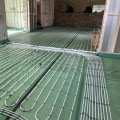Meanwhile, hydronic radiant heating, by which hot water passes through pipes under the floor, is more often designed into a new structure from the beginning and is generally more energy efficient.
Radiant heating
has a number of advantages. It is more efficient than baseboard heating and generally more efficient than forced air heating because it eliminates duct losses. People with allergies often prefer radiant heat because it doesn't distribute allergens like forced air systems do.Hydronic (liquid-based) systems use little electricity, a benefit for households off the grid or in areas with high electricity prices. Hydronic systems can use a wide variety of energy sources to heat the liquid, including standard oil or gas boilers, wood-fired boilers, solar water heaters, or a combination of these sources. For more information on the different types of energy sources and heat distribution systems for home heating, see our Energy Saver 101 infographic on home heating. Unlike gas-based or boiler-based systems, radiant heating systems are energy efficient and cost-effective.
Traditional radiators must heat up to 167 degrees Fahrenheit before you can heat a room. A radiant heating system only needs to reach 84 degrees Fahrenheit to heat the entire space. With duct-based heating systems, you'll always have a bit of duct loss.
underfloor heating creates radiant
heat that is evenly distributed.Underfloor heating heats a room evenly from the floor upwards without overheating, saving up to 15% on the average annual heating bill. Underfloor heating converts the entire surface of the floor into a radiant heating that creates an overall comfortable room temperature. While radiators distribute heat unevenly, creating hot and cold spots in a room, underfloor heating provides even heat distribution, which means that the system must work for a shorter period of time, saving energy and obtaining the same level of comfort. Electric underfloor heating systems are at least 25 percent more efficient than forced air systems.
This is because they do not provide an escape route for the heat they produce. Therefore, practically all the heat that is produced is retained. Conversely, forced air systems use ducts that are susceptible to leaks. In a forced air system, such heat loss occurs mainly in ducts, where even misaligned joints can leak to a considerable degree.
The convenience and cost savings of running the system on your heating bills will work in your favor in the long run. In addition, radiant heating systems do not require ongoing maintenance, allowing even more cost savings in the future. But, if you are building a new house and want to have underfloor heating everywhere, you should consider electric slab heating cables, which can be installed directly on a concrete slab, or a hydronic heating system on the floor. Electrical systems cost around £100 per square meter for individual wiring, while heating mats are cheaper (DIY stores sell 5 m2 carpets for less than £100, for example).
Because the floor area of a room is much larger, underfloor heating requires a lower inlet temperature, sometimes just 35°C,” says Matt Densham.
Underfloor heating
is safe to use with virtually all floor finishing materials, although it is more compatible with concrete, ceramic and porcelain or stone floors. Underfloor heating also distributes heat more evenly throughout the room for a more comfortable environment. Secondly, concrete very slowly releases the heat that it has gained, so if a homeowner decides that the temperature has risen too much, his fastest and most effective resource is to open windows to lower the temperature.To ensure that heat is evenly distributed throughout the space, an effective installation of your system is vital. Unlike electrical systems, hydronic underfloor heating systems are usually more expensive upfront because they require a boiler, pump, and gas lines to operate. You usually have to apply a self-leveling compound on top of your underfloor heating system, and this compound must be completely dry before you can lay the floor covering.
Underfloor
heating systems are energy efficient and do an excellent job of providing sustained and reliable heating for your entire home.The initial cost of a hydronic underfloor heating system is usually higher because it requires a boiler, pump and gas lines. . .











